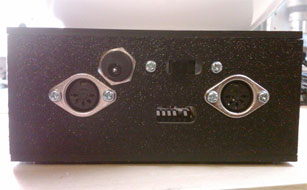ColorSynth Technical Information
|
Click HERE to download the ColorSynth Owner's Manual!Click HERE to download the "ColorSynth CONTROL" MAX/MSP patch!CONCEPTColorSynths are stage lighting effects, designed by and for electronic musicians. They translate MIDI messages into light and colors. Using a ColorSynth can be as simple as plugging it into the MIDI out port of your favorite keyboard, electronic drum kit, or other MIDI capable device. Advanced users can use software such as Ableton Live, Max/MSP, PureData and others to create complex lighting sequences. For the elctronic musician, ColorSynths offer a great advantage over current conventional lighting effects, as they do not require DMX hardware or software to operate. Simply connect to power and a MIDI source, and your ColorSynth is ready to add the most crucial element to your live musical performance - pretty, colorful blinky lights.
MIDI IMPLEMENTATION
ColorSynths interperets the following MIDI messages: Notes - Mapped to the colors of the RGB spectrum like this:
Continuous Controllers (CC):
HARDWAREThe
vibrant colors and intense light of the ColorSynths come from a high
power RGB LED, which is mounted on a heat sink inside of the enclosure.
The enclosure is made of ABS plastic, and is combination hand/machine
crafted in San Francisco, CA by On the back of the ColorSynth fixture are MIDI IN (left) and MIDI OUT/THRU (right) ports, a 6 position DIP switch, a DC power input that accepts 10-15V DC (center positive), and an on/off switch. Any data received at the MIDI IN port is processed and then echoed out the MIDI OUT port. The first four DIP switches assign the binary value of the ColorSynth's MIDI channel, which is shipped by default to channel 1. When in the UP/ON position, the 5th DIP switch engages a standalone mode. When in standalone, the first four DIP switches modify the behavior of the standalone mode.
**
SAFETY PRECAUTIONS **
|
ColorSynths are now
Public Domain!
(no more pesky patent applications)
Website designed by Eric Bateman using HTML technology perfected in 1995.
Optimized for Netscape 3.0


